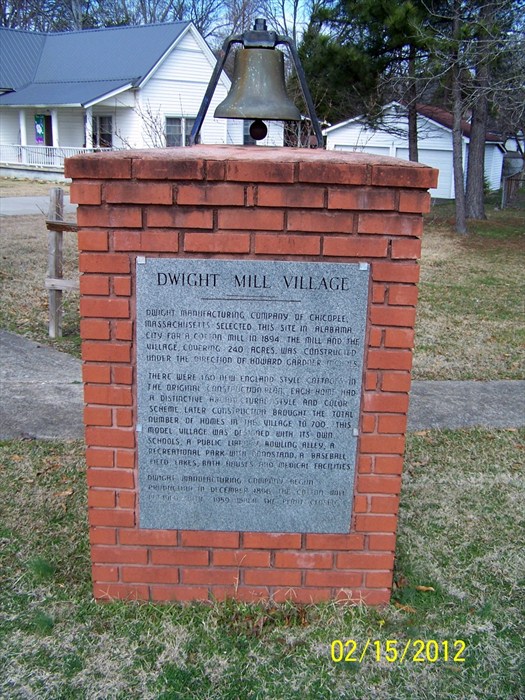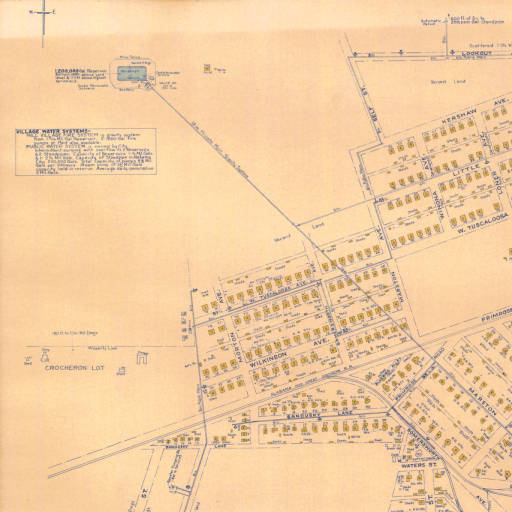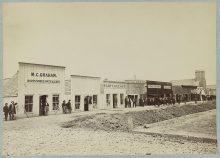HISTORIC VISIT
BY
A few years ago, I made a special effort to attend the Annual Meeting of the Alabama Historical Association. That year, the meeting was in Gadsden, AL near Attalla where I grew up. I was quite surprised to learn that one of their places of local interest was the site of the
Dwight Manufacturing Company in Alabama City, one of the Gadsden communities.
Family worked there
Dwight Manufacturing Company no longer existed; but had been a booming cotton mill when I was a child. I have fond memories of that location. The mother and aunt of one of my cousins worked there. They lived in company housing, which intrigued me. This would have been in the mid-late 1940’s. My cousin’s grandparents lived in the home too. They took care of their grand daughter while the two employed ladies were at work. By that time, child labor regulations were being enforced.
Minimum age was twelve
I did not realize until recently that those cotton mills had a reputation of working children younger than the now minimum age of fourteen. During the earlier days, the minimum was age twelve and the hours were more strenuous than the reduced hours permitted by today’s Child Labor Laws.
Whistles blew shift changes
The houses owned by the mill were within walking distance of the plant. When my parents, brother and I would visit our relatives, we could hear the shift change whistles blow. This was old hat to my Dad as he worked for a steel mill located in the same little town. It was, however, exciting for my brother and me.
Dwight Mill Village Map (Alabama Department of Archives)
Watching Shift Changes was exciting
A brother and sister-in-law of my Dad worked for the Coosa Manufacturing Company in Piedmont. An uncle of my Dad also worked there. We would occasionally time visits in the area to see my Dad’s brother as he was leaving work.
Seeing all those men and women moving in and out of the plant during shift change time was exciting for my brother and me. You must remember, there was no television at the time; so we got our excitement where ever we could find it! Fortunately we did not see any pre-teens reporting to work.
Demise was Devastating
The demise of the cotton mills in Alabama was devastating to the families who lived and worked in the mill towns. It had quite an impact on the economy of those towns. My cousin and her family relocated. My uncle and aunt who lived in Piedmont were fortunate enough to reach retirement age before the Coosa Manufacturing Company closed.
Related stories
List of Cotton Mills in Alabama with [1910 photographs and film] –
My first job at Sylacauga cotton Mill – with [rare film footage of Avondale Mills in 50’s]
Today, this old cotton mill village in Huntsville has been revitalized [vintage pictures]
Start researching your family genealogy research in minutes. This inexpensive Ebook has simple instructions on how to get started with FREE sources. Download WHERE DO I START? Hints and Tips for Beginning Genealogists with On-line resources
Reviews
“This book was very informative and at a very modest price. One web site I may have missed in your book that has been very helpful to me is genealogybank.com. I found articles about several of my ancestors in their newspaper archives. Thank you for your great newsletter and this book.”
“The book was clear & concise, with excellent information for beginners. As an experienced genealogist, I enjoyed the chapter with lists of interview questions. I’d recommend this book to those who are just beginning to work on their genealogies. For more experienced genealogists, it provides a nice refresher.”







I have mixed feelings on the whole “demise of the mills thing.” I grew up in two mill towns & saw the effects first hand. My step father was a supervisor in one of them. The idolization of that time in history hearkens to antebellum times, and ignores the fact that many people were injured or killed, with little to no compensation for the families, who were often unceremoniously kicked out of the company housing. Wages were basement wages at best, and indentured servitude at it’s worst.
Simply put, the companies were greedy, did not care about their workers (oh a fruit bag at Christmas? How nice.) & when people started standing up for their rights the companies shipped operations overseas where they will work for pennies and let you beat them into submission.
The Mill Town era remains “Mayberry” in most peoples minds, but the reality of that time rips the fabric of disillusionment.
Don’t know what mill your dad worked for but that’s not the experience of all mill workers. I lived in a town where Avondale Mills was the largest employer. They provided good pay and benefits to employees and were good members of the community donating money for civic improvement, etc.
Good pay ONLY because it was mandated by the government. I grew up in Lanett & Valley, the heart of 5 West Point Manufacturing plants, Lanett, Shawmut, Langdale, Riverview & Fairfax. I have done extensive research on textile milling & the companies who ran them. FEW were locally owned, most by folks in Boston. And they were only built here to save shipping costs. If they could have shipped the cotton economically there would have been no mills. I’m not saying they were necessarily evil or a bad thing, but all was not as rosy as some tell it.
And I know for a fact the companies were pissed off when they had to start safety measures & provide ear-plugs & air conditioners to remove the cotton dust from the air. Do you have any idea how many people died because they inhaled cotton dust for years?
For their time, they were a good thing. My dad started working at the Fayette Cotton Mill when I was a baby and retired after 42 years. He was a hard working man and was treated fairly. He made more there than he was making at two sawmill jobs. I started working there on weekends after turning 18, their minimum wage. It helped me get through college ad earn a better life for my family. For a good perspective on the mills and the people who worked there, read The Most They Ever Had by Rick Bragg.
Thank goodness FDR pushed for minimum wage. 🙂 When the federal minimum wage first became law in 1938, it was 25 cents. The G.I. Bill enabled many mill workers and their children to advance in life also. Good times.
I think better economy and expansion after WW II. Had more to do with it than FDR.
Yes, in my hometown of Haleyville, too. Can remember visiting relatives in the “mill village.”
I helped clean the mill village bricks about 35 years ago as a teen. Clean them and stack em on pallets. Ten cents per brick I believe.
My great grandmother who was born in 1872 remarked that the mills were a god send for post war families, most left with nothing but dirt to farm. As many of her people as possible found jobs in either the Langdale or Riverview mill and were thankful for the money they earned. I had family members who worked their way through the system into successful management positions, most returning from WW2 service and using the GI bill to get or complete an education. I always loved my summers spent in the communities there. If I remember correctly the demise of the Valley mills was pushed along in the 80s with a hostile take over from outside the Valley and then the final nail in the coffin was later as jobs were shipped over seas. Nothing in life stays the same forever and I do have “Mayberry ” memories of my family having a good life in these mill towns.